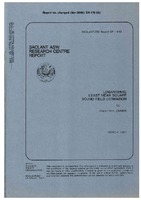| dc.contributor.author | Zimmer, Walter M. X. | |
| dc.date.accessioned | 2018-10-11T14:06:37Z | |
| dc.date.available | 2018-10-11T14:06:37Z | |
| dc.date.issued | 1987/03 | |
| dc.identifier | 1890 | |
| dc.identifier.govdoc | SR-110 | |
| dc.identifier.uri | http://hdl.handle.net/20.500.12489/278 | |
| dc.description.abstract | The report deals with narrowband beamforming techniques for passive sonar applications. In particular, the Least Mean Square fit parameter estimation technique is used to estimate the spatial sound-field power density. To avoid the computational intensive matrix calculation the steepest descent iteration has been selected to find the optimal solution. Comparisons have been made between the steepest descent and the so-called WB iteration, which was developed some years ago at SACLANTCEN by R. Wagstaff and J.-L. Berrou. The results of these two iteration procedures have been compared against the conventional beamformer using perfectly known data, simulated random data and real data. Also, a statistical performance analysis has been carried out to provide numerical evidence for the probability of detection and resolution and for the accuracy of bearing estimation. In this context the two sound-field estimation techniques have been compared not only with the conventional beamformer but also with the Capon adaptive beamformer and the MUSIC orthogonal beamformer. | |
| dc.format | 27 p. : ill. ; 9 fig. | |
| dc.language | English | |
| dc.publisher | NATO. SACLANTCEN | |
| dc.relation.ispartofseries | ADA180587 | |
| dc.subject | Passive sonar | |
| dc.subject | Probability of detection (PD) | |
| dc.subject | Target detection | |
| dc.subject | Beamforming | |
| dc.title | Logarithmic least mean square sound-field estimation | |
| dc.type | Scientific Report (SR) | |
